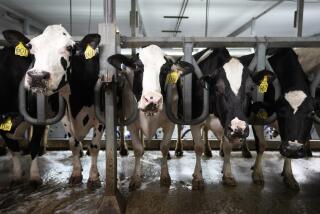Animal-to-People Transplants Raise Fears of New Germs
- Share via
In 1993, an official with the Centers for Disease Control and Prevention called a few employees into her office. Then she asked a question at least one of those employees viewed as silly:
What was the CDC doing about the risk that animal-to-people transplants would introduce new germs into the human population, infecting first the transplant recipient and then spreading to other people?
“My first reaction was, nothing,” recalled Louisa Chapman, an expert on animal viruses that infect humans. “Why should we waste taxpayer time and money on that?”
Transplants from animals were so rare and recipients lived so briefly that it didn’t seem a threat to public health, Chapman thought.
But as she looked into the situation, she changed her mind: Interest in such “xenotransplants” was heating up. Animals could not only ease the shortage of kidneys, hearts and livers for transplantation, but supply brain tissue for treating diseases like Parkinson’s and pancreatic tissue to treat diabetes.
These days, Chapman spends most of her time on xenotransplantation issues.
She’s not alone. Drug and biotech companies have poured more than $100 million into xenotransplant research. Scientists report progress in overcoming rejection of animal organs, and industry analysts expect a new round of organ experiments in people within three to five years.
The heavy betting now is on organs and tissue from pigs, rather than chimps and baboons as in the past.
But the concern Chapman heard in that 1993 meeting has not gone away: Would xenotransplants be a form of Trojan horse, giving new germs an entree into the human population?
In March, scientists at the Institute of Cancer Research in London reported that a virus--one that might be found even in healthy pigs--sprang out of pig tissue and infected human cells in a lab experiment. Then it reemerged from human cells in a form that apparently would slip by the body’s defenses.
That shows the idea of such infection in a pig-to-human transplant “is more plausible than a fanciful scare story,” the researchers said.
Two months earlier, the British government had slapped a moratorium on xenotransplants, chiefly because too little was known about the risk of infection.
And federal regulators in the United States now are refining draft guidelines to minimize the risk to public health. The guidelines discuss such things as keeping specialized colonies or herds of animals and screening them for germs.
People who get animal organs, cells or tissue should be followed for life for any sign of animal germs, and they should tell their “close contacts” about the possibility that such germs could be passed on, the guidelines say.
Close contacts could include sexual partners, health care workers and breast-fed children, Chapman said.
“We’re not talking about people who sit on the school bus with you or work in your office,” she said.
At this point, the concern over public peril is theoretical, a pile of what-ifs, a mound of maybes. It reminds Chapman of how NASA quarantined the astronauts from the first three moon-landing missions in case they had brought back weird germs.
“What we are saying is there’s some level of risk,” she said.
The task now is to figure out how big it is and what to do about it, she added.
Here’s why Chapman and others say there’s reason to worry:
* Animals do have germs that can infect people and then spread from person to person. The AIDS virus apparently came from monkeys long ago, for example, and the flu virus that killed more than 20 million people worldwide in 1918-19 emerged from pigs.
* Dangerous germs can hide in healthy-looking animals. Hantavirus doesn’t bother mice, but when it spreads to people, it can kill.
* A person who would be receiving animal organs would be on drugs to suppress his or her immune system. This could make it easier for an animal virus to gain a foothold.
* Genes from an animal virus could mingle with those of a human virus in an organ recipient, creating a hybrid virus with unpredictable behavior.
* Keeping animals isolated from infection may not be enough. Some viruses scientists are concerned about aren’t caught; they’re inherited.
They’re just part of being a pig, for example. That’s because, eons ago, these viruses infected the ancestors of modern pigs and planted their DNA in sperm and egg cells. As a result, the virus genes mingled with the pig genes and are now passed on through the generations.
It was just this kind of inherited virus that popped up in the pig-cell study reported in March.
So far, however, the limited experience with xenotransplants is encouraging.
Dr. Alan Dimick, who has put pigskin on severe burns since 1970, says there is no evidence that treatment has infected anybody with pig germs. But Dimick, director of the burn center at the University of Alabama at Birmingham, notes that the pigskin stays on for only a day or two. An implanted organ might pose more of a risk, he said.
Dr. James M. Schumacher, a Sarasota, Fla., neurosurgeon who has put fetal pig tissue into the brains of a dozen people with Parkinson’s or Huntington’s disease over the last two years, also reports no sign of infection.
While scientists ponder the risk of xenotransplantation, thousands of people die each year because they are unable to receive a human organ.
“It’s a difficult issue,” said virus expert Jonathan Allan of the Southwest Foundation for Biomedical Research in San Antonio, who calls the infection risk from pigs very small but worth worrying about.
“Here are people dying,” Allan said. “You want to do everything possible to prevent that sort of suffering. But you certainly don’t want to foster new infectious disease that would make even greater suffering in the population.”






